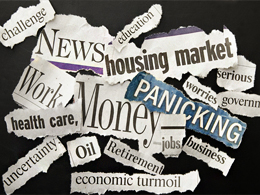 If you’ve been reading my posts over the past week, you’ve probably noticed a key theme: despite ongoing market turbulence, U.S. economic fundamentals remain strong.
If you’ve been reading my posts over the past week, you’ve probably noticed a key theme: despite ongoing market turbulence, U.S. economic fundamentals remain strong.
Today’s data underlined that point again. Economic growth for the second quarter was revised up substantially, from 2.3 percent to 3.7 percent—not only above expectations, at 3.2 percent, but beyond the higher end of the range of estimates.
In other words, the economy did better than pretty much anyone expected last quarter.
U.S. economic crisis not imminent
This kind of strong performance is the reverse of what we saw heading into the last crisis, when growth and other economic stats surprised to the downside. Couple today’s GDP figure with strong employment growth, strong consumer consumption growth (3.1 percent for the second quarter, an increase from the prior quarter’s growth rate of 2.9 percent), and a normalized housing market, and the chances of an economic crisis here in the U.S. seem minimal for the next year or two at least.
Looking forward, growth is also likely to maintain its pace. Bank lending continues to increase at a sustainable rate, consumer confidence continues to rise, and businesses keep growing their earnings, despite global turbulence.
These strong economic fundamentals are why I’ve been so emphatic about the probable downside limits to the U.S. stock market. As we’ve witnessed over the past week, though, the economy and the stock market are not the same thing. After I wrote yesterday’s post on the market’s downside risks, it proceeded to jump up, which was great to see.
But I think we’re making a mistake if we assume the turbulence is over.
Confidence has taken a hit
We often see a bounce back after a market downturn, but when it’s as large and as technically damaging as the most recent drop was, it certainly hurts confidence. To return to recent high valuation levels, investor confidence will have to recover, which is by no means guaranteed, especially given the potential for continued shocks from outside the U.S.
We have weathered the first-order effects of the Chinese yuan devaluation and market crash. But the second- and third-order effects are still working their way through the system and may surface to shake U.S. markets over the next several months. The chain of devaluations set off by China’s actions in emerging markets (and some developed ones) stands to rock economies and financial systems around the world, to the potential detriment of U.S. markets. Continued low commodity and oil prices, drawing on lower Chinese demand growth, will likely do the same.
Emerging market companies, for example, are reported to have taken on $9 trillion in debt denominated in U.S. dollars. If they earn their money in other currencies, that debt just got a lot more expensive. For every 11 percent their currency depreciates against the dollar, they effectively add another $1 trillion in debt to their liabilities in local currency terms. Soon, you’re talking real money.
Expect more negative headlines
Situations abroad will no doubt generate troubling headlines, possibly prompting less confident U.S. investors to pull back again. We will be hearing more negative news, and it will be more likely to rattle the markets in this new, less confident environment.
At the same time, though, U.S. economic fundamentals do remain strong. Turbulence is very likely to show up again—and maybe soon—but as long as the foundation remains sound, as it does here in the U.S., the damage should be both constrained and relatively short lived.


 Print
Print


